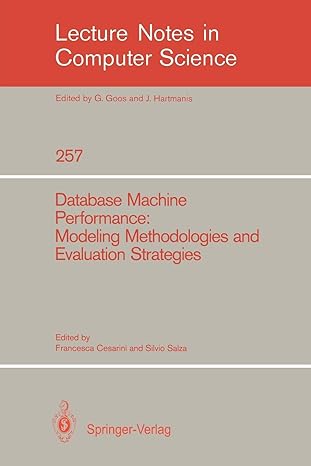Question
-----JAVA Implementations----------------------- public class Lab01 { private Lab01() { // empty by design } //Question 1 /** * Returns the minimum (most negative) value that
-----JAVA Implementations-----------------------
public class Lab01 {
private Lab01() {
// empty by design
}
//Question 1
/**
* Returns the minimum (most negative) value that an int can
* represent.
*
* @return the minimum (most negative) value that an int can represent
*/
public static int minInt() {
return 0;
}
/**
* Returns the minimum positive value greater than zero that a
* double can represent.
*
* @return the minimum positive value greater than zero that a double can
* represent
*/
public static double maxDouble() {
return 0;
}
//Ques 2
/**
* Removes the last two digits of a positive integer base 10 number that is
* greater than 99.
*
* @param n
* a positive integer number greater than 99
* @return the integer produced by removing the last two digits of n
*/
public static int removeLastTwoDigits(int n) {
return 0;
}
/**
* Returns the last one digit of a positive integer base 10 number that is
* greater than 9. If the last two digits start with a
* 0 then only the last digit is returned.
*
* @param n
* a positive integer number greater than 9
* @return the last one digit of n
*/
public static int lastOneDigit(int n) {
return 0;
}
public static int lastTwoDigits(int n) {
return 0;
}
/**
* Computes the age (in years) of a person using the following convoluted
* algorithm:
*
*
*
*
- start with the person's street address
*
- double it
*
- add 42 to the result from the previous step
*
- multiply the previous step by 50
*
- subtract the person's birthYear from the previous step
*
- subtract 50 from the previous step
*
- add the number of birthdays the person has had this year
* to the previous step
*
- subtract 34 from the previous step
*
- the last two digits of the previous step is the age of the person
*
*
*
* This algorithm works only for people aged 1-99, and for addresses less
* than approximately 20000000.
*
* @param address
* the person's street address number
* @param birthYear
* the person's birth year
* @param birthdays
* the number of birthdays the person has had this year (either 0
* or 1)
* @return the age of the person
*/
public static int yourAge(int address, int birthYear, int birthdays) {
return 0;
}
//Ques 3
/**
* Computes the standard Rayleigh distribution probability density function (see
* the lab document for the actual formula) with scale parameter.
*
* @param x
* a value
* @param sigma
* scale parameter
* @return the standard Rayleigh distribution probability density function
* evaluated at x
*/
public static double rayleigh(double x, int sigma) {
return 0;
}
//Ques 4
/**
* Computes the number of characters that are different in
* two strings of equal length. The strings are compared
* character by character and the number of characters that
* differ is returned. For example:
*
*
* Lab1.distance("talk", "talk") returns 0
* Lab1.distance("talk", "walk") returns 1
* Lab1.distance("well", "walk") returns 2
*
*
*
* @param s a non-null string
* @param t a non-null string
* @return the number of characters that differ between s and t
* @throws IllegalArgumentException if s and t have different lengths
*/
public static int distance(String s, String t) {
return 0;
}
//Ques 5
/**
* Determine if the point (x, y) is strictly inside the r
* with center (0, 0) and having radius equal to
* 1. A point on the perimeter of the circle is considered
* outside of the circle.
*
* @param x
* the x-coordinate of the point
* @param y
* the y-coordinate of the point
* @return true if (x, y) is inside the unit circle, and false otherwise
*/
public static boolean isInside(double x, double y) {
return false;
}
//Ques 6
/**
* Returns true if year is a leap year and false otherwise.
*
*
* A year is always a leap year if it is evenly divisible by 400; for all other
* years, a year is a leap year if it is evenly divisible by 4 and not evenly
* divisible by 100. For example:
*
*
* isLeapYear(2000) returns true (2000 is divisible by 400)
* isLeapYear(1900) returns false (1900 is divisible by 4 and 100)
* isLeapYear(2004) returns true (2004 is divisible by 4 but not 100)
* isLeapYear(2005) returns false (2005 is not divisible by 4)
*
*
* @param year
* a year
* @return true if year is a leap year and false otherwise
* @throws IllegalArgumentException
* if year is less than 1582 (the year the Gregorian
* calendar was adopted)
*/
public static boolean isLeapYear(int year) {
return false;
}
//Ques 7
/**
* Determine if a value x is strictly inside the given
* Range. A value exactly at the minimum or maximum of the range is
* considered outside of the range.
*
* @param x
* a value
* @param range
* a Range to check
* @return the value 1 if x is strictly inside the given Range, and 0 otherwise
*/
public static int contains(double x, Range range) {
return 0;
}
}
Step by Step Solution
There are 3 Steps involved in it
Step: 1

Get Instant Access to Expert-Tailored Solutions
See step-by-step solutions with expert insights and AI powered tools for academic success
Step: 2

Step: 3

Ace Your Homework with AI
Get the answers you need in no time with our AI-driven, step-by-step assistance
Get Started


